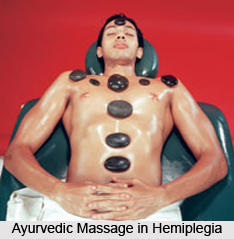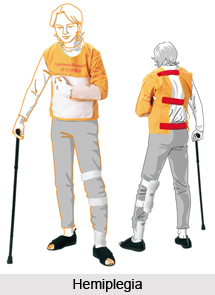 Hemiplegia, termed as `Pakshaghat` in Ayurveda, is a form of paralytic attack which affects one side of the body. `Paksha` means the limb and `Ghat` means hurt. The disorder occurs when the limbs stop functioning and are hurt in some ways. This is said to be pure Vata disorder. Hemiplegia weakens muscle activities and deactivates cell activities on one side of the body. The causes of this disease can be many like diabetes, hypertension, cerebral haemorrhage and head injury to name a few. The symptoms of Hemiplegia can be identified when one faces difficulty in mobility; numbness of extremities; muscle spasms; shoulder subluxation; loss of balance and control etc. Ayurvedic massage helps to cure Hemiplegia in an effective manner.
Hemiplegia, termed as `Pakshaghat` in Ayurveda, is a form of paralytic attack which affects one side of the body. `Paksha` means the limb and `Ghat` means hurt. The disorder occurs when the limbs stop functioning and are hurt in some ways. This is said to be pure Vata disorder. Hemiplegia weakens muscle activities and deactivates cell activities on one side of the body. The causes of this disease can be many like diabetes, hypertension, cerebral haemorrhage and head injury to name a few. The symptoms of Hemiplegia can be identified when one faces difficulty in mobility; numbness of extremities; muscle spasms; shoulder subluxation; loss of balance and control etc. Ayurvedic massage helps to cure Hemiplegia in an effective manner.
Procedure of Ayurvedic Massage
In case of Hemiplegia daily massage is strictly recommended. The massage is followed by heavy perspiration. Simple sesame oil, narayan oil, bala oil or karpasasthyadi oil can be used for this purpose.  These types of oils penetrate through the skin and improve muscle tone, which is lost in the disease of Hemiplegia.
These types of oils penetrate through the skin and improve muscle tone, which is lost in the disease of Hemiplegia.
During the massage, the patient is asked to lie down in a supine position. The massage is started in the affected part of the body. The direction is `anuloma` i.e. opposite to the body hair direction (`anu` means opposite and `loma` means bodily hairs). The oil is rubbed against the hair roots over the affected area. The oil straight penetrates in the skin and starts functioning.
The strokes of massage in case of Hemiplegia should be one way and not in backward movement. For example, when Hemiplegia occurs in hand, the massage should start from palm and reach the shoulder but never to come back from shoulder to the palm. If there are hundred strokes to be given, they should follow the direction of palm to shoulder only.
When the process is complete, steaming has to perform in the affected area with the herbal extraction and sometimes with medicated milk. Sometimes enema is applied with the medicated material. The medicated material is composed of oil, ghee, honey, roots of medicinal herbs, rock salt and many other ingredients as per the need of the disease and the patient.





